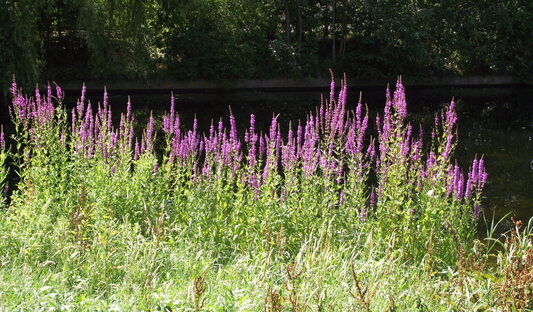Written by Industry Expert Jason Luce, Certified Lake Manager
Most of us know that invasive species are dangerous to the environment, but it can often be difficult to distinguish between native beneficial plants and these unwelcome invaders. This problem is compounded by the fact that many invasive species are beautiful and add incredible color and dimension to our landscapes. While many invasive plants are aesthetically pleasing, we cannot forget the toll they take on our valuable ecosystems.
 Purple loosestrife (Lythrum salicaria) is a highly invasive perennial that is a perfect example of this. The herbaceous plant is native to Eurasia and became known within the US shortly after the beginning of the nineteenth century. The spread to North America occurred in the 1800s. Seeds were sold in American and Canadian nurseries as early as the mid-1850s, and the seeds of the plant also made their way over in the ballast water of ships throughout the 1800s.
Purple loosestrife (Lythrum salicaria) is a highly invasive perennial that is a perfect example of this. The herbaceous plant is native to Eurasia and became known within the US shortly after the beginning of the nineteenth century. The spread to North America occurred in the 1800s. Seeds were sold in American and Canadian nurseries as early as the mid-1850s, and the seeds of the plant also made their way over in the ballast water of ships throughout the 1800s.
Today, gardeners can still purchase the plant from some seed catalogs even though it is known to be problematic. This is why management tends to focus on establishing control rather than proactive efforts. Still, it is important to understand the implications of such sales in order to educate the public and keep this invasive species from continuing its spread.
Our natural wetlands are made up of a diverse group of plants, and this plant diversity drives diversity in wildlife. Once a non-native species is introduced, the wetland can quickly shift from having hundreds of thriving native plants to only a handful of natives. In addition to being a fantastic producer, purple loosestrife has virtually no predators to control its population and spread. A single plant can produce 2.5 million seeds and these seeds can survive for years before germinating. Once purple loosestrife has become established, it will continue to spread and out-compete native vegetation, in turn decreasing the diversity of the native wildlife.
Purple loosestrife has a robust root mass and will survive even after the top is completely removed, making control difficult. Full excavation of the plant and root mass is the most effective long-term management strategy, but this option is very labor-intensive and expensive. For this reason, treatment and biological control are the two most practical and cost-effective options once the plant has become established. Biological control involves the use of insects, such as leaf-eating beetles, to affect the growth and seed production through leaf feeding. Biological control is an interesting and natural control option, but results can vary significantly. Overall, chemical control may be the best option in terms of price and effectiveness. It is important to keep in mind that control should take place immediately after a new infestation has been identified. Once the plant becomes established, control price will increase exponentially with time.
When it comes to the management of purple loosestrife, early detection through sound identification and rapid response to new infestations is critical. Property owners, managers, and residents are encouraged to keep a watchful eye on their ponds, fields, and wetlands for this purple invader. Acting swiftly to control only a few plants will not only have less impact on your budget but will also help to safeguard the integrity and biodiversity of your prized ecosystem.
Contact the experts at 888-480-5253 for all of your lake, pond, and fisheries management needs.
SOLitude Lake Management is committed to providing full service lake and pond management services that improve water quality, preserve natural resources, and reduce our environmental footprint. Our services include lake, pond and fisheries management programs, algae and aquatic weed control, mechanical harvesting, hydro-raking, installation and maintenance of fountains and aeration systems, water quality testing and restoration, bathymetry, lake vegetation studies, biological assessments, habitat assessments, invasive species management and nuisance wildlife management. Services, consulting and aquatic products are available to clients nationwide, including homeowners associations, multi-family and apartment communities, golf courses, commercial developments, ranches, private landowners, reservoirs, recreational and public lakes, municipalities, parks, and state and federal agencies. Learn more about SOLitude Lake Management and purchase products at www.solitudelakemanagement.com.










